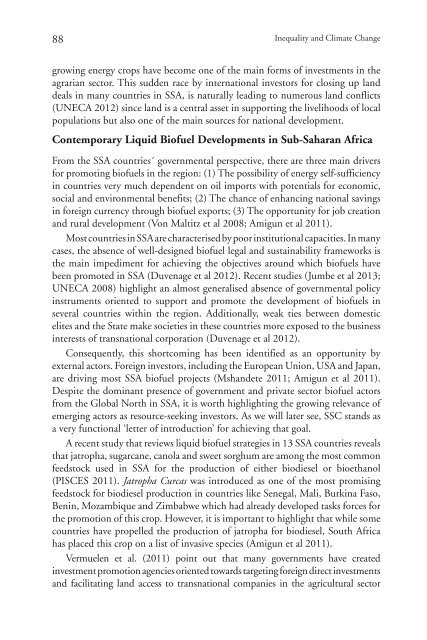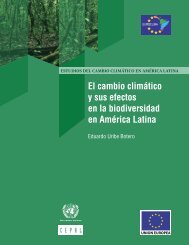Inequality and Climate Change Inégalité et changement climatique
Inequality
Inequality
You also want an ePaper? Increase the reach of your titles
YUMPU automatically turns print PDFs into web optimized ePapers that Google loves.
88<br />
<strong>Inequality</strong> <strong>and</strong> <strong>Climate</strong> <strong>Change</strong><br />
growing energy crops have become one of the main forms of investments in the<br />
agrarian sector. This sudden race by international investors for closing up l<strong>and</strong><br />
deals in many countries in SSA, is naturally leading to numerous l<strong>and</strong> conflicts<br />
(UNECA 2012) since l<strong>and</strong> is a central ass<strong>et</strong> in supporting the livelihoods of local<br />
populations but also one of the main sources for national development.<br />
Contemporary Liquid Biofuel Developments in Sub-Saharan Africa<br />
From the SSA countries´ governmental perspective, there are three main drivers<br />
for promoting biofuels in the region: (1) The possibility of energy self-sufficiency<br />
in countries very much dependent on oil imports with potentials for economic,<br />
social <strong>and</strong> environmental benefits; (2) The chance of enhancing national savings<br />
in foreign currency through biofuel exports; (3) The opportunity for job creation<br />
<strong>and</strong> rural development (Von Maltitz <strong>et</strong> al 2008; Amigun <strong>et</strong> al 2011).<br />
Most countries in SSA are characterised by poor institutional capacities. In many<br />
cases, the absence of well-designed biofuel legal <strong>and</strong> sustainability frameworks is<br />
the main impediment for achieving the objectives around which biofuels have<br />
been promoted in SSA (Duvenage <strong>et</strong> al 2012). Recent studies (Jumbe <strong>et</strong> al 2013;<br />
UNECA 2008) highlight an almost generalised absence of governmental policy<br />
instruments oriented to support <strong>and</strong> promote the development of biofuels in<br />
several countries within the region. Additionally, weak ties b<strong>et</strong>ween domestic<br />
elites <strong>and</strong> the State make soci<strong>et</strong>ies in these countries more exposed to the business<br />
interests of transnational corporation (Duvenage <strong>et</strong> al 2012).<br />
Consequently, this shortcoming has been identified as an opportunity by<br />
external actors. Foreign investors, including the European Union, USA <strong>and</strong> Japan,<br />
are driving most SSA biofuel projects (Msh<strong>and</strong><strong>et</strong>e 2011; Amigun <strong>et</strong> al 2011).<br />
Despite the dominant presence of government <strong>and</strong> private sector biofuel actors<br />
from the Global North in SSA, it is worth highlighting the growing relevance of<br />
emerging actors as resource-seeking investors. As we will later see, SSC st<strong>and</strong>s as<br />
a very functional ‘l<strong>et</strong>ter of introduction’ for achieving that goal.<br />
A recent study that reviews liquid biofuel strategies in 13 SSA countries reveals<br />
that jatropha, sugarcane, canola <strong>and</strong> swe<strong>et</strong> sorghum are among the most common<br />
feedstock used in SSA for the production of either biodiesel or bio<strong>et</strong>hanol<br />
(PISCES 2011). Jatropha Curcas was introduced as one of the most promising<br />
feedstock for biodiesel production in countries like Senegal, Mali, Burkina Faso,<br />
Benin, Mozambique <strong>and</strong> Zimbabwe which had already developed tasks forces for<br />
the promotion of this crop. However, it is important to highlight that while some<br />
countries have propelled the production of jatropha for biodiesel, South Africa<br />
has placed this crop on a list of invasive species (Amigun <strong>et</strong> al 2011).<br />
Vermuelen <strong>et</strong> al. (2011) point out that many governments have created<br />
investment promotion agencies oriented towards targ<strong>et</strong>ing foreign direct investments<br />
<strong>and</strong> facilitating l<strong>and</strong> access to transnational companies in the agricultural sector





